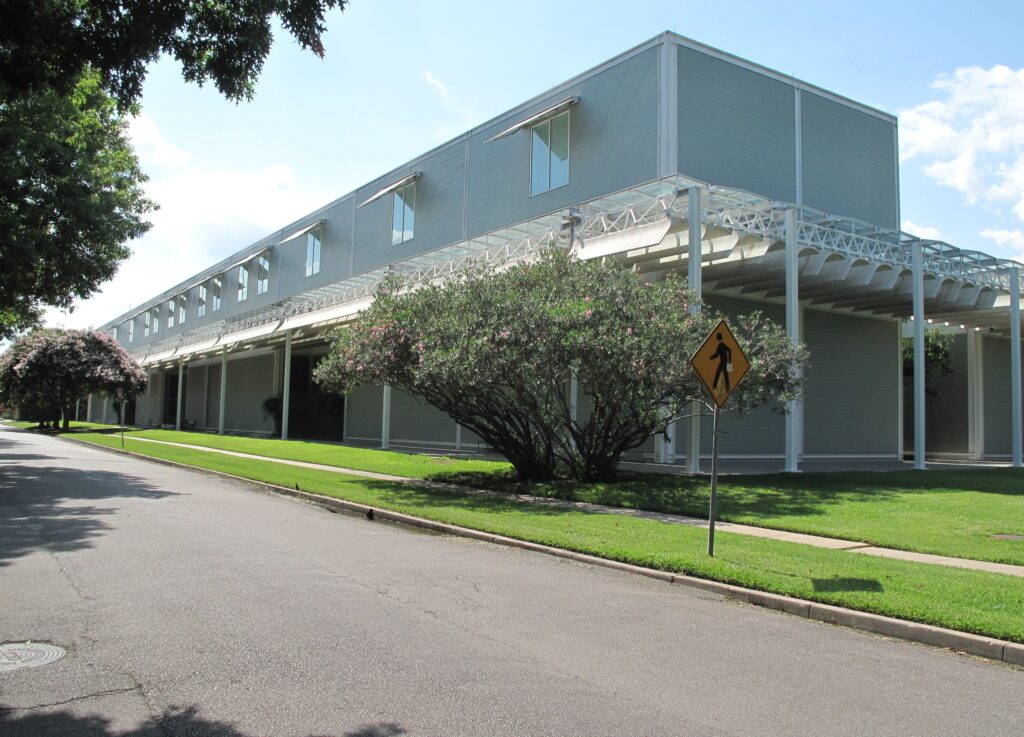Texas experienced profound change throughout the middle of the last century. A fast-growing population, vast sums of new wealth and changing expectations about the ways people of all races would live together all played a role.
And with these seismic shifts came new kinds of buildings – more ambitious homes and public structures, renowned architects to design them, and a place for Texas’ architecture on the world stage.
In their new book, “Home, Heat, Money, God: Texas and Modern Architecture,” author Kathryn E. O’Rourke and photographer Ben Koush tell the story of the Lone Star State and the buildings that shaped it from the 1930s to the 80s. Listen to the interview above or read the transcript below.
This transcript has been edited lightly for clarity:
Texas Standard: I think a lot of people are drawn to architecture and what buildings tell us about ourselves. It’s interesting you start in the 1930s, because I’m thinking there was a big celebration here in Texas for its centennial. I noticed that you begin the book with Lamar High School in Houston, built in 1937, one year after that centennial features a giant limestone map of Texas positioned above the entrance. Kathryn, why did you want to start there?
Kathryn O’Rourke: Well, I started there for the reasons that you suggested. Number one, because there’s a map of Texas, and I wanted to put the image of the state forward. And here was a building that literally had the picture of the state on it.
And exactly because the 1930s and the Centennial Fair are so important in beginning to shape the story that we still tell sometimes about Texas: the myth, the history. And because it’s an important moment in modern architecture, as a lot of ideas that were coming out of Western European architectural practices start to get spread around the world and including Texas.
You know, Texas is such an enormous state, and you obviously have different cultural forces at work. And you’ve also got these buildings going up at the same time: homes, skyscrapers, public buildings, churches, big cities, small towns, famous architects, not-so-famous architects. How did you approach this? And what was the thread that you were looking for to tie all of this together?
O’Rourke: Well, it really began this project with Ben’s photographs – and he can talk about that – he picked the pictures all over the state for many, many years. And so I had this wealth of images and building types and architects to work with.
And one of the goals very early on came to be to tell as many stories as we could and incorporate different building types in small towns and big cities, and to try to suggest a sense of the diversity, the breadth and the multiplicity of buildings and stories in this huge state.
Ben, when you set out taking these pictures, did you have the book already in mind?
Ben Koush: No. It was a long, drawn-out process. I came to Houston in 1998 to get a master’s degree in architecture at Rice University and found out about all the great architecture in the state through a professor at Rice named Stephen Fox, who was a real mentor to me and is an architecture historian.
And I started documenting all the buildings I saw around me once I started to learn how to identify them and find out where they were. Just started trying to take as many pictures as I could because many of the buildings were being demolished.
I started putting the buildings that I photographed on Instagram, and people were asking, “oh, is there going to be a book?” I spent time organizing the images and realizing how many I had. I had about 40,000.
Of those 40,000 images, are there one or two that really stand out to you as like, boy, you see this, you think there’s a story here?
Koush: That’s a tough question. A lot of people ask that, and we don’t have a good answer because the problem is every building is good and there’s too many good buildings in the state. We’re just really lucky to have such a great architectural legacy.
If you ask me what my favorite building in Houston is, I always say the Menil Collection building. This is the museum building that was designed by Renzo Piano, who is an Italian architect, and built for the Manil family, who were French American art collectors. And, they ran Schlumberger, which is an oil well service company.
The building that he designed for them is really remarkable, I think, for the way that it addresses the context: It’s surrounded by little 1920s bungalows, and it’s very, very respectful, even though it’s a modern building and much larger. But it feels like it fits just perfectly and actually has this magical ability to look very small on the outside, but then when you go inside of it, it’s extremely spacious and lofty.

The Menil Collection building in Houston. Francisco Anzola via Flickr (CC BY 2.0)
I have to ask you, Kathryn, because I mentioned the centennial, and I know that this is not just single structures that you focus on. You know, there’s the Fair Park in Dallas as an important project, very different from what went before in Dallas. Can you talk about the impact?
O’Rourke: Oh, certainly. Fair Park and the centennial celebrations are hugely important. I think it’s a watershed moment in the history of the state. Fair Park, of course, is being redesigned by Bergdoll and a host of other architects and has many artists involved in making those buildings be what they are. And at the same time, all over the state, buildings are being identified as historically significant. We see a real growth in historical markers.
And so part of what’s happening there with that space is a kind of locus, is that the idea of Texas is beginning to be really forged in a concrete way that’s both architectural but also is going to be sort of imaginative, if you will, throughout the state, right – that people are starting to drive around in their cars and they see these historical markers, and it produces this notion that there is this singular place called Texas that is connected to land and history and to buildings.
Well, let’s zoom in a little bit more on the idea of the car interacting with these buildings. As you walk away from looking at these pictures, what is that idea as you see it? Is there a way of putting it into words?
O’Rourke: Well, you know, the car is obviously such an important thing here. Also because of the centrality of the oil industry to the history of the state in the 20th century. And I think part of what I was thinking about in doing this book was the extent to which even thinking about architecture in Texas is an imaginative act that’s also connected to travel, getting on the road and going out and discovering these buildings and seeing these places.
But the other piece of the car story, I think, is to see how many buildings were, of course, built for cars at mid-century, especially, and then how many buildings have been demolished in order to make parking lots. And that’s a huge loss, right? And now we’re at a moment, I hope, where people are starting to think differently about automobiles and moving more toward mass transit and walking and bikes and all that.
Ben, what do these images tell you about the idea of Texas and that mid-century imprint?
Koush: It really talks about what an expansionist period of time it was in Texas. And people were looking at things both inside the state and outside the state. You have regional architects like O’Neil Ford, based in San Antonio, looking at indigenous examples of architecture in the Hill Country and Mexico and then incorporating that into designs.
And then in Houston, you have people like Howard Barnstone looking at Mies van der Rohe and Philip Johnson and the most avant garde kind of architectural design in the United States at the time. So it’s very wide-ranging and not parochial and not provincial. It is very cosmopolitan. And I think that’s very exciting to see Texas engaging in that kind of of thought and discourse.














